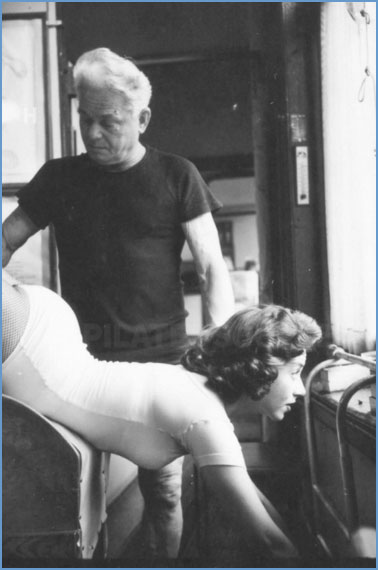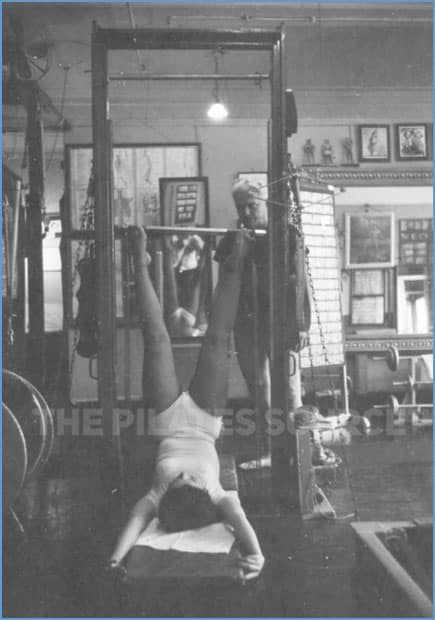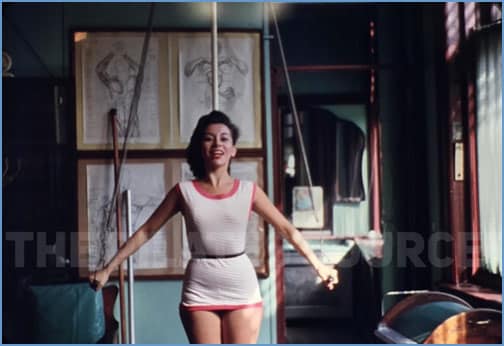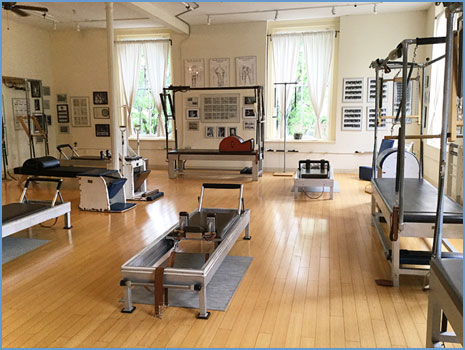The Pilates Method is complete coordination of the mind, body, and spirit. Its a method of corrective exercise that strengthens and tones the entire body. The exercises emphasize the core muscles- primarily abdominals, inner thighs, and glutes to support the back- as well as spinal and muscular flexibility The movements are flowing, precise and challenging, and build a “mind-body-spirit” connection that translates into one’s daily activities and improves quality of life.
Photos of Joseph Pilates with Elaine Malbin, taken by John Vachon for Look Magazine; Library of Congress.
Joseph Hubertus Pilates’ Early Life
Joseph H. Pilates was born in Mönchengladbach, a small town near Düsseldorf, Germany in 1883
At five years of age, Joseph lost the sight of his right eye, apparently due to bullies wielding stones at him. Also at a young age, like many other children of the times, he suffered from health issues. However, Joseph’s father was a gymnast, which had a great influence on encouraging him to take control of his health. Joseph and his brother began practicing boxing, self defense and gymnastics. He took personal responsibility for his own health and overcame weakness. He spent time alone in the woods observing animals and how they naturally moved. Later as an adult, he would claim to have been so fit as a teenager that he actually posed for anatomy books, although that claim has yet to be proven.
As a young adult in during World War I, Joseph Pilates was living in England and making a living as a human statue in the circus. In 1914, the British authorities eventually brought him to an internment camp, along with other German citizens, for the remainder of the war. Although wartimes were bleak, it was during his time at the camp that he began to develop specific ideas for his new exercise method. He spent his time observing animals at the camp, such as cats, and how they stretched and moved about to stay limber. He saw how men at the camp could lose strength easily if they had nothing to keep them active. He began to teach floor exercises (what would later become known as “the Mat Work”) to these men in an effort to keep up their strength and morale. The exercises included abdominal work, leg and arm work, balancing exercises, and spinal movements in all planes: flexion, extension, side bending, and rotation, as they were based on the German gymnastics Joseph learned as a child. Joe himself said that these men survived the 1918 flu pandemic due to their good physical condition.
While Joe did develop his matwork in the internment camp, it is not likely that he developed ideas for any of his apparatus there. Some speculate that he was inspired by the beds in the camp and the springs under the mattress, and that he took the springs from under the beds and attached them above to create pilates apparatus. However, this is unproven. The beds for those interned in the camp did not have springs under the mattresses, especially since it was wartime and metal was not being used for bed springs in internment camps. Not to mention if he took the springs off the beds, the mattresses would have fallen to the floor!
After WWI and he was released, he returned to Germany and continued training people with the exercises he developed in the camp at his boxing gym. It is at this point in Germany when we first see signs of his apparatus ideas, such as advertisements for The Universal Reformer, as well as his first patent filed- The Foot Corrector. In time, he was pressured to train members of the German army and he instead decided, at age 42, to emigrate to America, where he planned to further his career in physical fitness, open a gym, and apply for more patents.
It was on the ship to America that Joe met his future life partner, Clara. Clara was a school teacher suffering from arthritis in her hands. It is said that Joe gave her a few exercises to help her hands and she soon became pain free. Sold on his technique, Clara joined him in New York City where they patented his pieces of exercise equipment, starting with what Joseph called, “The Universal Reformer.” They opened up a gym together at 939 8th Avenue. The focus of the gym was boxing and “Contrology”- the name Joe gave to his exercise technique. He continued to teach the mat work he had developed in the camp, and created additional, similar exercises on the Universal Reformer and the other apparatus he built and invented.
Within the same building were dance and art studios, which made for an eclectic group of people throughout the whole building who became devoted disciples of Joe and Clara. They found that doing Contrology (aka Pilates) improved their form, increased their stamina, and helped them recover from injuries. Clients of the gym consisted of dancers, artists, singers, and choreographers- many of them famous- as well as plenty of regular people who just wanted to exercise or wanted help recovering from injuries.
The Contrology Gymnasium in New York City
Joseph Pilates’ gymnasium was like none other. It consisted of unique apparatus with a unique set of exercises for each apparatus. The exercises, the method, and the equipment throughout the room was all invented by Joe. Many pieces doubled as exercise equipment and functional furniture. Clara assisted Joe with the teaching of the exercises. Over the years, he built and designed many pieces of equipment, different types of furniture, as well as a game and a toy. However, only about a dozen of the apparatus are still widely used in pilates studios today.
To know and see Joe teaching Contrology in those days would be an amazing experience. Known to wear only shorts while teaching, he would also smoke cigars while in the studio. This was part of Joe’s marketing for his method. He would say, “Look at me- smoking and drinking and loving!”, while in perfect health, which he attributed to his method. Clara almost always wore her signature nurse’s dress. The walls of the studio were covered with an eclectic collection of art, photography, sculpture, and exercise charts.
While teaching, Joseph was known as a man who could be harsh and to the point- very matter-of-fact in telling his clients what to do and how to do an exercise. There is a well known photograph of Joe standing on top of the stomach and rib cage of opera singer, Roberta Peters, while she was in the middle of an exercise, to teach her how to use her abdominals to protect and support her back properly. He was a stickler for form, saying, “A few well-designed movements, properly performed in a balanced sequence, are worth hours of doing sloppy calisthenics or forced contortion.” Clara, on the other hand, was known as the kinder teacher, who would focus more on the flow of the movements. Today, the pilates method is truly a combination of both of their approaches to teaching.
When a new client would knock on the downstairs door of the building to come in, Joe would have them come all the way up the stairs, where he would greet them with one of his inventions- a small device he called “The Breath-a-cizer.” He would have them blow into it and give them the assessment that they were obviously terribly out of shape and needed to come in a get fit with Contrology.
Once they were in the gym, he or Clara, or one of the teachers employed there would give them a personalized workout, which they were expected to memorize and do on their own each time they visited the gym. If they weren’t able to memorize it, they could follow all with the photos of the exercises that Joseph had hanging all over the gym. Each apparatus had a corresponding chart of small, black and white photos of Joe demonstrating exercises on all his equipment, in a particular order and in perfect form.
The bulk of the Contrology workout was done on the Universal Reformer. This was a wooden bed frame (complete with claw feet) with a “mat” attached to weighted springs so it could slide back and forth within the frame. He was very serious about correcting poor posture and spinal health, which meant that the mat was not soft and comfortable, but instead, firm.
Names of exercises on the reformer ranged from clear and to the point, “Biceps,” “Overhead,” and “Long stretch,” to intriguing and fun, “Corkscrew,” “Horseback,” and “Snake.” Once his clients were done on the reformer, they would move on to a few more pieces of equipment, one of them being the Cadillac. It was a raised bed with metal framework and springs, straps, and bars attached to it. The springs and bars aided the clients with resistance and assistance to all the exercises. Each of these springs and bars had a specific use and name, such as leg springs, arm springs, roll back bar, push through bar, and trapeze bar, and hanging fuzzies. Students would do exercises that focused on spinal flexibility and full body alignment, as well as gymnastic-type moves.
Clients would also work out on The Barrels, which were primarily used for spinal flexibility and extension. The story behind Joe’s process of inventing the barrels is that he took an empty beer barrel and cut it in half, then covered it with upholstery. This created a “hump,” for clients to arch their backs over or do a series of exercises on. Which exercises they could do depended on the height and placement of the barrel. After inventing The Barrel, he was left with the metal rings from around the beer barrels, and not wanting to leave anything to waste, he invented The Magic Circle. The Magic Circle is a small piece of equipment that we use very often in pilates classes today. It’s a small metal circle with two soft pads on it (though when Joe invented his original Circles, those pads were just blocks of wood) used to teach people how to engage their innermost muscles to get the most out of the work out.
Is the story behind the Barrel and the Magic Circle true? Click here to find out! But it makes for a great story, which was yet another thing that Joe was a genius at creating.
When clients were done working out, Joseph Pilates would say, “After an hour, get in the shower!” He insisted that all clients take a cold shower after exercising and- like most other things in his life- he felt very passionate about how exactly it should be done. He was even known to get into the shower with people to teach them proper washing and scrubbing techniques! Before a student walked out the door, they would take an apple with them.
One way he tried to spread his method was by selling his equipment and charts to use along with it through a catalog for people to use at home. The Wunda Chair, Spine Corrector, Bench Mat, and Massage Table are all examples of this. The Junior Reformer is another piece of equipment that he tried to sell for home use.
Other than the apparatus listed above and previously in this article, Joe invented many other pieces of equipment, between additional exercise equipment (like the Ped-o-pul, The Gym-in-the-Door, The Toe Corrector, Finger Exerciser, Magic Square, and Tensometer, as well as furniture. Today, we recognize nearly hundreds of exercises of Joseph Pilates.
Other Inventions and Endeavors
One of his most well known pieces of furniture that he built and invented was “The Bednasium.” The Bednasium was a v-shaped bed that Joseph Pilates believed would help with all the aches and pains associated with sleep for some people. He promoted the Bednasium through self-marketing, through articles and his books, and even soliciting bed and mattress companies to stop building beds flat and to start building all beds in the V shape. When bed manufacturers wouldn’t make his beds, he was outraged. His niece, Mary Pilates, has said that she remembers sleeping in the Bednasium and that it was quite comfortable.
Joe spent much of his time passionately marketing his method. There were articles about his method and gym in the New York Times, Sports Illustrated, Life Magazine, and Reader’s Digest, to name a few. He was a true showman, and is even quoted in Life Magazine as stating he was a direct descendant of Pontius Pilate. He also wrote two books, “Return to Life Through Contrology,” and “Your Health,” where he vigorously discussed not only how his method could help everyone physically, mentally, and spiritually, but also how children should be raised, how people should sit and sleep, and how to eat healthfully. Despite the popularity of his method and the genius behind his inventions, towards the end of his life it was said that he was a depressed man. He had intended for Contrology to be an internationally recognized exercise system but it never reached that status within his lifetime. He was sad that his method was taken over by dancers. Ironically, it was those dancers who continued to spread his method throughout the world after his death and made pilates what it is today. He would say, “I’m 50 years ahead of my time!” And he was right.
Both during and after Joe’s lifetime, some of his students went on to teach the Pilates exercises on their own, opening their own studios and teaching the exercises that were taught to them by Joe. There is a story about one of his students, Bob Seed, who tried to open a Contrology gym a few blocks away from Joe with the promise to open a few hours earlier than Joe did. Apparently Joe wasn’t going to let that happen, so he showed up at Bob’s door with a shotgun and told him to get out of town. Is it a true story? No one knows for sure, but it does make for some good drama!
Other students of Joe’s who continued to teach his method (some added their own methods and ideas to what he taught them) are Romana Kryzanowska, Carola Trier, Kathy Grant, as well as many others.
In 1967, Joseph Pilates passed away from emphysema at the age of 86. His obituary read, “a white-maned lion with steel blue eyes (one was glass from a boxing mishap), and mahogany skin, and as limber in his 80’s as a teenager.”
After his death, Clara continued to run the gym, although she was going blind. Eventually, one of their students, Romana Kryzanowska, took over the studio to carry on Joe’s work as he taught it. Romana famously carried on Joe’s original method closer than any other student did, and taught hundreds of her own students who became certified pilates teachers, until 2013 when she passed away at age 90.
In 1992 Sean Gallagher purchased the original Pilates Studio business and pilates archives from Wei Tai Hom. It was due to this, and his work with Romana, that the first ever fully comprehensive pilates teacher training program was created under Pilates Inc. Through Pilates Inc, Romana traveled the world training people to become pilates teachers, which is the main reason why Authentic Pilates exists in so many studios today. Soon after, Sean Gallagher also purchased Joseph Pilates’ original property in the Berkshires of Massachusetts, which contained his original studio, home, belongings, and equipment. Today we are working to restore this property and turn the studio into a pilates museum and working studio.
Pilates Today
Today, there are thousands of pilates teachers worldwide and millions of people benefitting from the method every day. The term “Pilates” has become a type of exercise that almost everyone has heard of. There are now different types of pilates, or different “schools of thought,” variations on the technique, and different companies manufacturing different versions of his apparatus.
In 2001, due to a lawsuit between Sean Gallagher and Current Concepts (now known as Balanced Body) the term “pilates” legally became a generic term. Despite Sean’s efforts to maintain specificity and quality in regards to the word pilates, the court ruled in Current Concept’s favor that anyone can use the name to mean anything, even if it is something that Joe specified it should not be. Fortunately, there are many teachers who respectfully carry-on Joe’s legacy through their studios and teaching, such as graduates from The New York Pilates Studio® teacher training program, still in operation today. Rhinebeck Pilates is one such studio to host this training program.
Fortunately, it is still possible to witness pilates history firsthand in a number of ways. Rhinebeck Pilates is home to many pieces of apparatus originally built and used by Joseph Pilates in his NYC studio, as well as original apparatus from Carola Trier’s studio. Many more, original apparatus is owned by Sean Gallagher at Joe’s original studio in the Berkshires and can be experienced during Pilates at The Pillow® or by visiting Sean’s Pilates Museum/Studio by appointment.
How can you know if the exercises you’re doing are truly Pilates, or a modern hybrid? The best place to start is to find a teacher listed on this website: www.classicalpilates.net.
Joseph Pilates was a genius and a true visionary. These days, anyone looking to try pilates serves themselves best by seeking out a classical or authentic pilates teacher who teaches as close to his original method as possible, with equipment built according to his specifications. Personally, as a pilates teacher myself for the past 24 years, I’ve seen countless people of all types benefit in extreme ways by following the teachings of Joseph Pilates, including myself.




